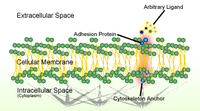
Photo from wikipedia
Two-photon lithography allows writing of arbitrary nanoarchitectures in photopolymers. This design flexibility opens almost limitless possibilities for biological studies, but the acrylate-based polymers frequently used do not allow for adhesion… Click to show full abstract
Two-photon lithography allows writing of arbitrary nanoarchitectures in photopolymers. This design flexibility opens almost limitless possibilities for biological studies, but the acrylate-based polymers frequently used do not allow for adhesion and growth of some types of cells. Indeed, we found that lithographically defined structures made from OrmoComp do not support E18 murine cortical neurons. We reacted OrmoComp structures with several diamines, thereby rendering the surfaces directly permissive for neuron attachment and growth by presenting a surface coating similar to the traditional cell biology coating achieved with poly-d-lysine (PDL) and laminin. However, in contrast to PDL-laminin coatings that cover the entire surface, the amine-terminated OrmoComp structures are orthogonally modified in deference to the surrounding glass or plastic substrate, adding yet another design element for advanced biological studies.
Journal Title: ACS applied materials & interfaces
Year Published: 2019
Link to full text (if available)
Share on Social Media: Sign Up to like & get
recommendations!